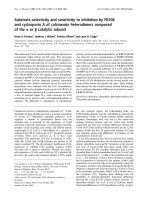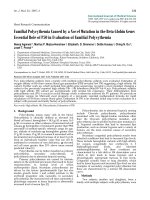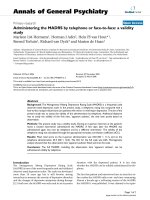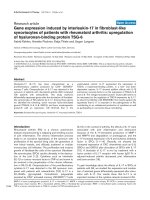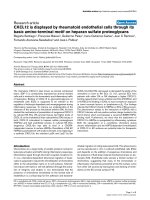Báo cáo y học: " Targeting viral infection by microRNA inhibition" pdf
Bạn đang xem bản rút gọn của tài liệu. Xem và tải ngay bản đầy đủ của tài liệu tại đây (188.03 KB, 4 trang )
Hepatitis C virus and microRNAs
MicroRNAs (miRNAs) are gaining an increasingly
promi nent role as regulators of numerous cellular pro-
cesses, including virus-host interactions. ey are short
(21-23 nucleotide) non-coding regulatory RNAs that
infl uence gene expression at a post-transcriptional level
[1]. miRNAs are encoded as part of long nuclear trans-
cripts, which are processed in the nucleus by Drosha,
then exported to the cytoplasm and further processed by
Dicer. e resulting mature miRNA strand is loaded into
the RNA-induced silencing complex (RISC), which acts
as the eff ector of miRNA activity [1]. In animals, target
specifi city is usually determined by a 6-8mer ‘seed’ at the
5’ end of the miRNA. Typically, miRNAs bind sites in the
3’ untranslated regions (UTRs) of mRNAs that have
perfect complementarity to the seed but imperfect
complementarity to the remainder of the miRNA. e
precise mechanism of miRNA-mediated repression is not
fully defi ned; both translational repression and degrada-
tion of miRNA-RISC-bound mRNAs have been observed
in diff erent studies [1].
Several viruses interact with the miRNA pathway. Certain
viruses produce their own miRNAs, which regulate viral
or cellular targets, whereas some viruses are regulated
directly or indirectly by cellular miRNAs [2]. One impor-
tant virus that has a requirement for a specifi c miRNA is
hepatitis C virus (HCV). HCV infects the liver and is a
major global health concern, with an estimated 170
million people infected worldwide [3]. In the majority of
cases acute infection with HCV progresses to chronic
infection, although infection can be cleared spontaneously
in a minority of cases. Chronically infected individuals
may then develop cirrhosis of the liver and may ultimately
progress to hepatocellular carcinoma. HCV is predomi-
nantly spread through direct blood contact, although
there is some evidence to suggest a possible (minor)
route of sexual transmission [3]. A report recently pub-
lished in Science [4] shows that inhibiting a specifi c
miRNA in chimpanzees chronically infected with HCV
reduces viral load.
HCV has a single-stranded positive-sense RNA genome
that encodes a single polyprotein that is processed to ten
viral proteins (Figure 1). e single open reading frame is
fl anked by two structured UTRs that are required for
replication [5]. e 5’ UTR of HCV contains an internal
ribosome entry site (IRES) that drives translation of the
open reading frame [5]. Within the fi rst 45 nucleotides of
the 5’ UTR are two seed matches for miR-122 (Figure 1),
a highly expressed liver-specifi c miRNA accounting for
about 70% of the total liver miRNA population (about
66,000 copies per cell) [6]. ese sites bind to miR-122
and are conserved across all six HCV genotypes. is
interaction is required for viral replication in cultured
cells [7-9]. e mechanism by which miR-122 regulates
HCV remains uncertain, with reports of enhancement at
the level of either translation or replication [7,10]. It is
possible that there is a complex regulatory mechanism
that aff ects both processes.
It is possible to perturb miRNA activity by using
complementary oligonucleotides directed against specifi c
miRNAs. Following introduction into cells, the oligo-
nucleo tide is bound by the appropriate miRNA in complex
with RISC. is prevents the miRNA from interacting
with its targets. Various chemical modifi cations improve
binding affi nity and stability of these inhibitors. miR-122
has been targeted eff ectively in mice using 2’-O-methy-
lated or 2’-O-methoxyethylated antisense oligo nucleo-
tides [11,12]. Researchers at Santaris Pharma took a
similar approach to silence miR-122 in mice, using anti-
sense oligomers containing locked nucleic acid (LNA), a
bicyclic nucleic acid analog that provides superior target
specifi city and stability and low toxicity [13]. is strategy
was extended to target miR-122 in primates using a
molecule with an optimized combination of LNA and
DNA bases and a phosphorothioate backbone (SPC3649;
Figure 1) [14]. Eff ective, long-lasting knockdown of
Abstract
An inhibitor of microRNA-122 reduces viral load
in chimpanzees that are chronically infected with
hepatitis C virus, suggesting that such an approach
might have therapeutic potential in humans.
© 2010 BioMed Central Ltd
Targeting viral infection by microRNA inhibition
Ashley PE Roberts and Catherine L Jopling*
MINIREVIEW
*Correspondence:
School of Pharmacy, Centre for Biomolecular Sciences, University of Nottingham,
University Park, Nottingham NG7 2RD, UK
Roberts and Jopling Genome Biology 2010, 11:201
/>© 2010 BioMed Central Ltd
miR-122 levels was observed, coupled with derepression
of endogenous targets and absence of signifi cant asso-
ciated toxicity [14].
miR-122 knockdown reduces HCV load in infected
chimpanzees
e conserved and essential nature of the miR-122-HCV
interaction, and the eff ective non-toxic in vivo suppres-
sion of miR-122 in primates by SPC3649, off ers an
exciting strategy to target HCV. In a new study [4],
Lanford et al. have begun to assess the therapeutic
potential of SPC3649 in chimpanzees chronically infected
with HCV.
Four chimpanzees chronically infected with genotype 1
HCV isolates were used in this study. Two were treated
with a high-dose regime (5 mg/kg SPC3649) and the
remaining two were given a low-dose regime (1 mg/kg
SPC3649). Baseline samples were taken for 4 weeks
before treatment with SPC3649, and the two samples
taken immediately before treatment were accompanied
by administration of an intravenous saline placebo.
SPC3649 was administered by weekly intravenous injec-
tion for 12weeks followed by a 17-week treatment-free
follow-up period [4].
is study [4] demonstrates that SPC3649 has a strong
potential as a therapeutic agent. Treatment with the drug
led to the de-repression of endogenous target mRNAs, in
keeping with previous studies. Furthermore, SPC3649
therapy resulted in a reduction of viral load by up to 2.6
orders of magnitude for HCV genome equivalents in
serum and up to 2.3 orders of magnitude in tissue in
high-dose animals. One of the low-dose animals showed
a similar but reduced response, whereas the other did not
respond. HCV RNA fl uctuated in the non-responding
animal, and endogenous miR-122 targets were also
unaff ected, suggesting that miR-122 was not eff ectively
inhibited [4].
Importantly, no escape mutants were detected by deep
sequencing of HCV genome samples, implying that the
interaction of miR-122 with HCV genomes is critical in
vivo and suggesting that resistance to SPC3649 therapy
might not be generated by mutation in miR-122 binding
sites. Rebound of viral load did not occur during therapy,
and took at least 15 weeks to return to pretreatment
levels after withdrawal of the drug. Encouragingly, the
half life in vivo of SPC3649 is in the order of 20 days,
presenting the possibility of longer periods between
administrations without sacrifi cing eff ectiveness once
Figure 1. miR-122 targeting HCV. The HCV RNA genome is shown with coding regions as rectangles and the 5’ and 3’ UTRs as lines. Structural
genes are in blue and non-structural genes in purple. The two seed matches bound by miR-122 are highlighted in red in an expanded view of the
5’ UTR. The sequence of miR-122 is shown in black, with the seed (nucleotides 2-8) in red. The SPC3649 molecule that targets it is shown with LNA
indicated in orange (C in orange indicates LNA methylcytosine) and DNA in green. The backbone is phosphorothioate.
IRES
C E1
E2
NS2
NS3
NS4B
NS5A
NS5B
p7 NS4A
5' UTR 3' UTR
UGGAGUGUGACAAUGGUGUUUGU
CCTCACACTGTTACC
miR-122
SPC3649
5' 3'
5'3'
A
U
G
GCCA GACACUCCACCAUGAAUCACUCC
GC
CG
CG
CG
CG
CG
UU
GA
miR-122
seed match 1
5'
miR-122
seed match 2
Roberts and Jopling Genome Biology 2010, 11:201
/>Page 2 of 4
miRNA suppression is achieved. An improvement in liver
histology also occurred in response to SPC3649 therapy,
suggesting that damage induced by HCV infection might
be reparable [4].
Implications for human HCV therapies
e results of this study are very exciting. Previous work
demonstrating a role for miR-122 in the HCV life cycle
was carried out in cell culture, so the discovery that this
miRNA has similar eff ects in infected animals is highly
signifi cant. e good safety profi le and stability of
SPC3649 give it considerable promise for human therapy.
Clinical trials of SPC3649 in human patients will be
very important, as results obtained in chimpanzees will
not necessarily extrapolate to humans, and trials across
larger populations may reveal diff erent responses. e
chimpanzee is a very useful model for HCV infection, but
there are signifi cant diff erences between the pathogenesis
of viral infection in chimpanzees and humans [15].
Chimpanzees experience milder symptoms than humans,
and cirrhosis has not been detected in infected animals.
Chronically infected chimpanzees show no reduction in
viral load in response to interferon therapy, and may
therefore be more valid as a model for human non-
responders [15]. e reduction in viral load following
treat ment with SPC3649 was accompanied by normali-
zation of the endogenous interferon pathway, which is
maximally induced in chronically infected chimpanzees
[4]. SPC3649 might thus be able to convert human non-
responders to responders and to allow eff ective interferon
therapy.
Analysis of liver biopsies from HCV-infected humans
showed no positive correlation between hepatic miR-122
expression and viral load [16]. Patients who were
unresponsive to interferon therapy had signifi cantly
lower miR-122 levels prior to treatment than responders
[16]. However, miR-122 expression is very high in the
liver, so even reduced levels could be suffi cient to support
HCV replication. Interestingly, chimpanzees receiving a
low dose of the drug in the Lanford et al. study [4] did
not respond as well as high-dose animals, despite
miR-122 being undetectable by Northern blot, lending
support to the hypothesis that low levels of miR-122 can
support viral replication [4]. It is also possible that the
subpopulation of hepatocytes infected with HCV may
show a diff erent correlation between miR-122 and HCV
levels to that observed in the liver as a whole.
e most encouraging aspects of this study [4] are the
lack of liver toxicity in treated animals and the obser-
vation that escape mutations in the miR-122 binding sites
did not emerge over the course of therapy. is is in
contrast to the rapid acquisition of adaptive mutations in
response to drugs that target viral proteins, and
emphasizes the benefi ts of targeting a host factor. ere
are potential problems in targeting an endogenous
miRNA as expression of endogenous targets will change;
however, the overall eff ect of de-repression of miR-122
targets was a benefi cial change in cholesterol levels. Many
diff erent measures of liver toxicity were examined over the
course of the study without any apparent therapy-induced
toxicity [4]. However, problems might arise over longer
treatment courses, or some time after treatment. Follow-
up of the treated chimpanzees will be important.
e current therapy for HCV uses interferon-α,
covalently attached to a polyethylene glycol molecule to
improve pharmacokinetics and stability, in combination
with ribavirin, a guanosine analog. e mechanisms by
which these drugs act are not well understood, and direct
inhibition of HCV replication and modulation of the
immune response may both be involved. Although this
treatment is a great improvement on interferon mono-
therapy, it is ineff ective in many cases, highly toxic, and
poorly tolerated [17]. An eff ective alternative with few
side eff ects is therefore highly desirable. Several clinical
trials are underway to test compounds directed against
viral or cellular targets. e results obtained with two
HCV protease inhibitors in combination with existing
therapy are especially promising and are now in phase III
trials [18]. However, resistance to these new drugs has
been detected, and the inclusion of interferon means that
poor tolerance remains a problem [18]. An interferon-
free treatment regime may require a combined small-
molecule approach similar to that used in HIV treatment,
combining protease inhibitors with other emerging anti-
HCV drugs, such as polymerase inhibitors. If the anti-
miR-122 drug proves to be eff ective and safe in humans,
it could form part of such a therapy. An enhanced reduc-
tion in HCV replication in cell culture when miR-122
sequestration was accompanied by treatment with lova-
statin, an inhibitor of isoprenoid biosynthesis, supports
the possibility that SPC3649 could be eff ective in a
combined therapy [19].
is research is likely to pave the way for future
miRNA-based therapeutics. Altered expression of specifi c
miRNAs is associated with many human diseases,
particularly cancers. miR-122 is relatively easy to target
because antisense oligonucleotides can be delivered to the
liver by intravenous injection. miRNAs in other organs
may be more diffi cult to target and thus require specialized
delivery methods. For some miRNAs it may be necessary
to improve delivery of antisense oligo nucleotides by
methods such as conjugation to cell penetrating peptides
[20]. ere is also potential for plasmid or viral-based
delivery of inhibitors using miRNA ‘sponges’, in which
multiple targets for the miRNA of interest compete with
the endogenous target [21]. Overexpression of miRNAs in
whole animals could also be achievable using techniques
under development for RNA interference.
Roberts and Jopling Genome Biology 2010, 11:201
/>Page 3 of 4
In conclusion, the results of this study show con-
siderable promise for the development of an eff ective,
well-tolerated therapy against HCV.
Acknowledgements
We thank Martin Bushell for critical reading of the manuscript. Research in the
authors’ laboratory is funded by a BBSRC David Phillips Fellowship to CLJ.
Published: 26 January 2010
References
1. Carthew RW, Sontheimer EJ: Origins and mechanisms of miRNAs and
siRNAs. Cell 2009, 136:642-655.
2. Umbach JL, Cullen BR: The role of RNAi and microRNAs in animal virus
replication and antiviral immunity. Genes Dev 2009, 23:1151-1164.
3. Thomson BJ: Hepatitis C virus: the growing challenge. Br Med Bull 2009,
89:153-167.
4. Lanford RE, Hildebrandt-Eriksen ES, Petri A, Persson R, Lindow M, Munk ME,
Kauppinen S, Orum H: Therapeutic silencing of microRNA-122 in primates
with chronic hepatitis C virus infection. Science 2010, 327:198-201.
5. Lindenbach BD, Rice CM: Unravelling hepatitis C virus replication from
genome to function. Nature 2005, 436:933-938.
6. Chang J, Nicolas E, Marks D, Sander C, Lerro A, Buendia MA, Xu C, Mason WS,
Moloshok T, Bort R, Zaret KS, Taylor JM: miR-122, a mammalian liver-specifi c
microRNA, is processed from hcr mRNA and may downregulate the high
affi nity cationic amino acid transporter CAT-1. RNA Biol 2004, 1:106-113.
7. Jopling CL, Yi M, Lancaster AM, Lemon SM, Sarnow P: Modulation of
hepatitis C virus RNA abundance by a liver-specifi c MicroRNA. Science
2005, 309:1577-1581.
8. Jopling CL, Schutz S, Sarnow P: Position-dependent function for a tandem
microRNA miR-122-binding site located in the hepatitis C virus RNA
genome. Cell Host Microbe 2008, 4:77-85.
9. Randall G, Panis M, Cooper JD, Tellinghuisen TL, Sukhodolets KE, Pfe er S,
Landthaler M, Landgraf P, Kan S, Lindenbach BD, Chien M, Weir DB, Russo JJ,
Ju J, Brownstein MJ, Sheridan R, Sander C, Zavolan M, Tuschl T, Rice CM:
Cellular cofactors aff ecting hepatitis C virus infection and replication. Proc
Natl Acad Sci USA 2007, 104:12884-12889.
10. Henke JI, Goergen D, Zheng J, Song Y, Schuttler CG, Fehr C, Junemann C,
Niepmann M: microRNA-122 stimulates translation of hepatitis C virus
RNA. EMBO J 2008, 27:3300-3310.
11. Krutzfeldt J, Rajewsky N, Braich R, Rajeev KG, Tuschl T, Manoharan M, Sto el
M: Silencing of microRNAs in vivo with ‘antagomirs’. Nature 2005,
438:685-689.
12. Esau C, Davis S, Murray SF, Yu XX, Pandey SK, Pear M, Watts L, Booten SL,
Graham M, McKay R, Subramaniam A, Propp S, Lollo BA, Freier S, Bennett CF,
Bhanot S, Monia BP: miR-122 regulation of lipid metabolism revealed by in
vivo antisense targeting. Cell Metab 2006, 3:
87-98.
13. Elmen J, Lindow M, Silahtaroglu A, Bak M, Christensen M, Lind-Thomsen A,
Hedtjarn M, Hansen JB, Hansen HF, Straarup EM, McCullagh K, Kearney P,
Kauppinen S: Antagonism of microRNA-122 in mice by systemically
administered LNA-antimiR leads to up-regulation of a large set of
predicted target mRNAs in the liver. Nucleic Acids Res 2008, 36:1153-1162.
14. Elmen J, Lindow M, Schutz S, Lawrence M, Petri A, Obad S, Lindholm M,
Hedtjarn M, Hansen HF, Berger U, Gullans S, Kearney P, Sarnow P, Straarup EM,
Kauppinen S: LNA-mediated microRNA silencing in non-human primates.
Nature 2008, 452:896-899.
15. Boonstra A, van der Laan LJ, Vanwolleghem T, Janssen HL: Experimental
models for hepatitis C viral infection. Hepatology 2009, 50:1646-1655.
16. Sarasin-Filipowicz M, Krol J, Markiewicz I, Heim MH, Filipowicz W: Decreased
levels of microRNA miR-122 in individuals with hepatitis C responding
poorly to interferon therapy. Nat Med 2009, 15:31-33.
17. Pawlotsky, J-M: Mechanisms of antiviral treatment effi cacy and failure in
chronic hepatitis C. Antiviral Res 2003, 59:1-11.
18. Nelson DR: Hepatitis C drug development at a crossroads. Hepatology 2009,
50:997-999.
19. Norman KL, Sarnow P: Modulation of hepatitis C virus RNA abundance and
the isoprenoid biosynthesis pathway by microRNA miR-122 involves
distinct mechanisms. J Virol, 84:666-670.
20. Fabani MM, Gait MJ: miR-122 targeting with LNA/2’-O-methyl
oligonucleotide mixmers, peptide nucleic acids (PNA), and PNA-peptide
conjugates. Rna 2008, 14:336-346.
21. Ebert MS, Neilson JR, Sharp PA: MicroRNA sponges: competitive inhibitors
of small RNAs in mammalian cells. Nat Methods 2007, 4:721-726.
Roberts and Jopling Genome Biology 2010, 11:201
/>doi:10.1186/gb-2010-11-1-201
Cite this article as: Roberts APE, Jopling CL: Targeting viral infection by
microRNA inhibition. Genome Biology 2010, 11: 201.
Page 4 of 4


